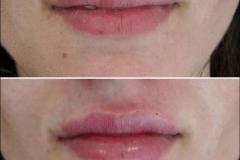Fill out the enquiry form to book an appointment and get the price list.
Dermal Fillers
WHAT ARE DERMAL FILLERS AND WHY DO WE USE THEM?
Dermal fillers are injectable substances used to fill in wrinkles, lines, and hollow areas of the face to restore volume and smoothness. They are commonly used in cosmetic procedures to enhance facial features and reduce signs of aging. Dermal fillers can also be used to add volume to lips, cheeks, and other areas, providing a more youthful and rejuvenated appearance.
The most common types of dermal fillers are:
Hyaluronic Acid Fillers: These fillers use hyaluronic acid, a substance naturally found in the skin, joints, and connective tissues. Examples include Juvederm and Restylane. They are versatile and can be used to add volume, smooth wrinkles, and enhance facial contours.
Calcium Hydroxylapatite (CaHA): This filler is composed of calcium particles suspended in a gel. It stimulates collagen production and is often used for deeper wrinkles and to restore volume in larger areas. Radiesse is a common CaHA filler.
Poly-L-lactic Acid (PLLA): This type of filler stimulates collagen production and is often used to treat facial volume loss over time. Sculptra is an example of a PLLA filler.
Polymethylmethacrylate (PMMA): This filler contains tiny microspheres that remain in the skin for a long time. It is used for deep wrinkles and acne scars. Bellafill is a common PMMA filler.
Dermal fillers are used for various reasons:
Wrinkle Reduction: Fillers can be injected into lines and wrinkles to smooth them out, providing a more youthful appearance. Wrinkles around the mouth, wrinkles around the eyes can be improved with soft fillers.
Volume Restoration: As we get older, we start using volume from the bones, from the fat pads, leading to sagging and hollowed areas. Dermal fillers can restore volume in these areas, such as the cheeks, temples, jawline, under eyes.
Lip Enhancement: Fillers are commonly used to add volume and definition to the lips.
Contouring and Shaping: Dermal fillers can be strategically placed to enhance facial contours and create a more aesthetically pleasing profile. Like more defined jawline, more defined and contoured highlighted cheek bones.
Dark Circles: Hollowness under the eyes can cause darker look and you may look more tired. Injecting dermal fillers under the eyes can give more brighter and you can look more rested.
Rejuvenation and Hydration: Some special fillers with non-crosslinked hyaluronic acid can be used to hydrate and rejuvenate the skin.
Acne Scar Treatment: Certain types of fillers, such as PMMA fillers, are used to fill in depressed scars caused by acne or other skin conditions.
It’s important to note that while dermal fillers can provide excellent results, the procedure should be performed by a qualified and experienced medical professional to ensure safety and achieve natural-looking results. Additionally, the effects of most fillers are temporary, and repeat treatments are often needed to maintain the desired appearance.
Hyaluronic acid fillers can be dissolved with an enzyme called “ Hyalase “ or “ Hyaluronidase” in case of an emergency or unpleasant results.
FREQUENTLY ASKED QUESTIONS
Q: How long do dermal fillers last?
A: The duration varies depending on the type of filler used. Generally, hyaluronic acid fillers last about 6 to 18 months, while others, such as calcium hydroxylapatite, can last up to a year or more. Results are not permanent, and follow-up treatments are usually required to maintain the effects.
Q: Are dermal filler injections painful?
A: Discomfort is typically minimal, and many dermal fillers contain a local anesthetic to enhance comfort during the procedure. Some individuals may experience mild bruising or swelling after the injections, but these effects are usually temporary.
Q: How long does it take to see results from dermal fillers?
A: Results are often visible immediately after the treatment, though there may be some initial swelling. As any swelling subsides, the full effects become more apparent over the following days.
Q: Are there any side effects or risks associated with dermal fillers?
A: Common side effects include bruising, swelling, redness, and tenderness at the injection site. Serious complications are rare but can include infection, allergic reactions, and lumps. It’s crucial to choose a qualified and experienced practitioner to minimize risks.
Q: Can dermal fillers be reversed if I’m unhappy with the results?
A: Yes, some types of dermal fillers, particularly those made with hyaluronic acid, can be partially or completely reversed using an enzyme called hyaluronidase. This allows for adjustments or corrections if necessary.
Q: How long is the recovery time after dermal filler injections?
A: Downtime is typically minimal. Most people can resume normal activities immediately after the procedure. However, it’s advisable to avoid strenuous exercise and excessive sun or heat exposure for a short period.
Q: Can I combine dermal fillers with other cosmetic procedures?
A: Yes, many individuals choose to combine dermal fillers with other treatments like Botox or laser therapy for a more comprehensive facial rejuvenation. Consult with your practitioner to determine the best approach for your specific needs.
Q: Who is a good candidate for dermal fillers?
A: Good candidates are generally in good health, have realistic expectations, and are seeking to address specific cosmetic concerns, such as wrinkles, volume loss, or facial asymmetry. Pregnant or breastfeeding women should avoid dermal fillers, and individuals with certain medical conditions may not be suitable candidates.
Always consult with a qualified healthcare professional for personalized advice and to address any concerns or questions you may have about dermal fillers.
























